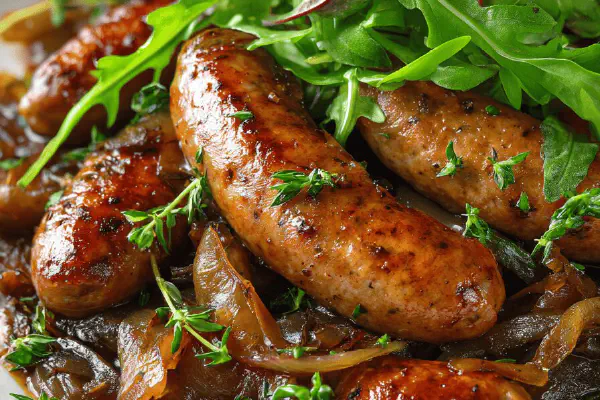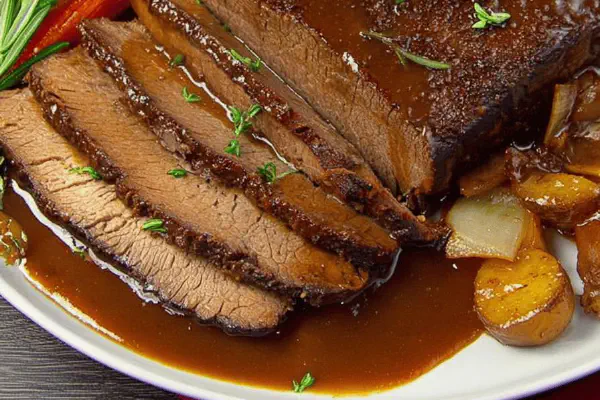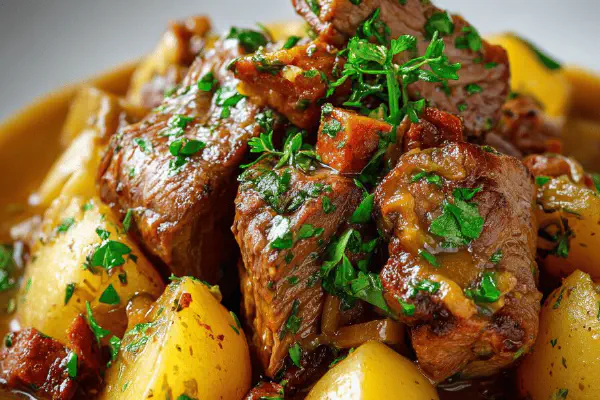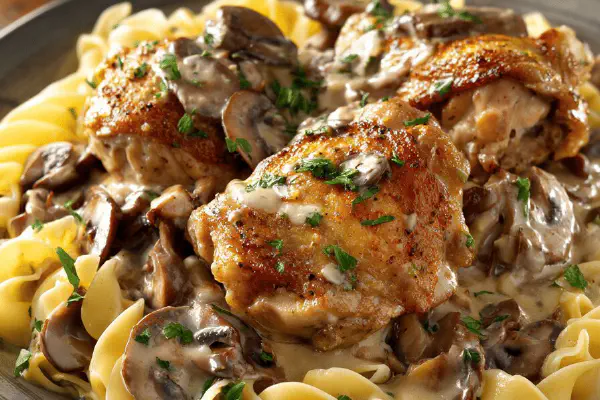Braised Italian Sausages Red Wine

By Emma
Certified Culinary Professional
Ingredients
- 7 sausages, Italian style pork
- 45 ml (3 tbsp) olive oil
- 4 medium onions, thinly sliced
- 320 ml (1 1/3 cups) dry red wine
- 280 ml (1 1/5 cups) beef broth
- 1 fresh thyme sprig
- 1.5 ml (1/3 tsp) smoked paprika
- 12 g (1/3 cup) chopped arugula
- Salt and black pepper, to taste
About the ingredients
Method
- Start with a heavy skillet on high heat. Pour in full olive oil dose, wait till it shimmers but not smokes.
- Tuck sausages in, searing until golden crust forms all around—listen for that sizzle; crust means flavor locked inside. Takes about 6 minutes but trust the color, not the clock.
- Ditch sausages on a plate; lower to medium heat. Same pan, no washing—fond underneath. Scatter sliced onions. Stir often. You want soft but not brown, about 7 minutes—onions turning glassy with sweet freckled edges.
- Splash in the wine immediately. The pan will roar again—deglaze now or never. Use a wooden spoon to scrape all those brown bits up. Wine reduces, bubbles shrink. Roughly 6 minutes until it smells fruity with a hint of alcohol gone.
- Slide sausages back in; turn a few times. Pour in beef broth, toss in thyme and smoked paprika. Cover loosely with foil or lid. Simmer gently—small bubbles, slow tease. About 20 minutes until sausages feel springy and cooked through if poked with a fork but no juice leaks.
- Raise heat, remove lid. Reduce sauce, let it thicken and slack down by nearly 75%. Sauce will stick to sausages and onions—lustrous, robust. Season carefully with salt and cracked pepper; taste often because broth is salty, wine tart.
- Before serving, toss the chopped arugula over everything. It softens slightly in warmth, adds fresh peppery contrast. Skip if you hate bitter greens—use chopped flat-leaf parsley instead.
- Serve with quick polenta or crusty bread to soak that sauce up. Watch out for oversalting—broth varies wildly. If sauce too thin after simmering, crank heat, stir constantly to avoid burning. If it thickens too fast and sausages still firm, add a splash more broth and cover.
- Twist: Swap beef broth for chicken broth for lighter taste. Thyme for rosemary if sturdier herb needed. Smoked paprika is sneaky—it’s subtle but adds smoky punch unlike chili flakes’ hot burn.
Cooking tips
Chef's notes
- 💡 High heat searing sets the flavor base. Oil must shimmer before sausages hit pan. Not smoking but nearly so. Listen close for sizzle or crust won’t develop. Patience for color. No poking early. Color over clock there.
- 💡 Onions slice thin, not chunks. Thinner means softer quicker but still some texture remains. No browning, aim glassy with flecks of golden crispness, like freckles. Stir often or burn lurks at edges. Sweetness emerges not bitter.
- 💡 Deglaze quick with dry red wine. Splash makes pan roar—don’t wait. Scrape every crumb with wooden spoon. That fond equals flavor depths. Wine reduces for 6 minutes, fruit scent over alcohol sharpness fades, that’s key timing.
- 💡 Simmer covered low after adding broth, herbs, and smoked paprika. Small bubbles, just teasing. Sausages firm but yield to poke, no juice leaks. Slow finish keeps meat tender, avoids toughness. Shake lid, rotate sausage occasionally for even cooking.
- 💡 Final uncovered simmer thickens sauce big time. Watch it reduce almost 75 percent, stick to meat. Sauce is lustrous, coats sausage and soft onions. If too thin, crank heat, stir or add broth splash if thickens too fast before ready.
- 💡 Arugula tossed in last minute keeps fresh pepper pop, no wilting. Parsley substitute if bitter greens offend. Adds contrast to smoky paprika and sweet onions. Don’t add too early or it turns slimy and bitter. Timing is everything.
- 💡 Broth choice matters. Beef broth gives deeper, weightier base while chicken broth lightens flavor. Thyme more subtle than rosemary—swapped when herbs got too punchy before. Smoked paprika quieter than chili flakes, no hot burn but full warmth.
- 💡 Salt at end only after sauce reduces. Broth salt levels vary wild. Salt early and risk oversalt, no fix except dilution. Taste often once sauce thickened to finesse seasoning. Be cautious with cracked pepper too. Layer season slow.
Common questions
How do I know when sausages are done?
Poke, feel bounce back. Juice should be clear, no red leaks. Sausage feels springy not hard. Avoid timing only. Meat texture and juices give best clues. Watch for sauce thickness too.
Can I swap sausage type?
Yes, but adjust cook time. Chicken sausages cook faster, lighter in flavor. Beef or turkey work, but flavor changes. Links must be thick enough to avoid drying. Adjust herbs or paprika if you want deeper or lighter profile.
Sauce too thin after simmer?
Crank heat, stir often but watch bottom. Add broth splash if thickens too quick but sausages still raw inside. Patience key here. Sauce must cling but meat cooked through. Avoid high flame from start or burn happens.
How to store leftovers?
Cooling quickly is best. Fridge in airtight container for 3 days. Freeze okay but sauce texture slightly changes. Reheat gently on stove, add splash broth or water if thickened too much. Avoid microwave reheating to keep texture decent.



